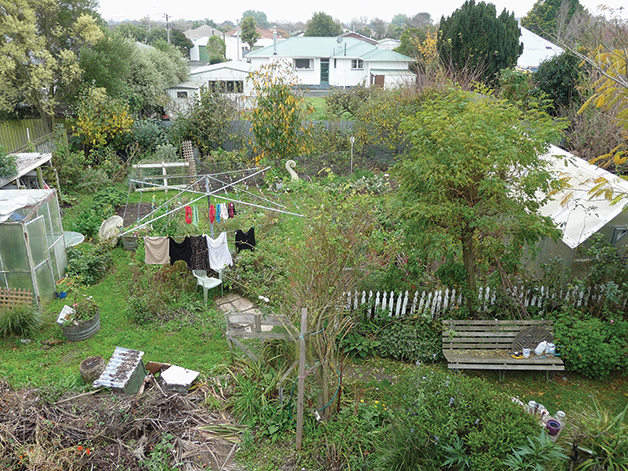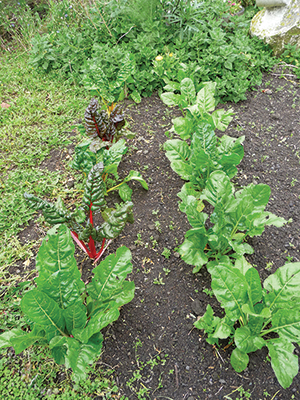Hei Mahi Māra Toxic legacy
Jul 17, 2014

A beginner’s guide to growing organic vegetables
nā Tremane Barr

Overview of garden which may have everything removed, dug out and replaced
This need to test was triggered by the regional council Environment Canterbury (ECAN) finalising its policies on identifying properties that may have had historical hazardous activities or industries on them. These Hazardous Activities and Industries List (HAIL) zone properties need to be tested to ensure the soil on them does not contain high levels of heavy metals and/or hazardous chemicals. By one estimate as many as 11,000 properties throughout Canterbury are at risk of having a toxic legacy from previous land uses. The main risk factors from historical land use are:
• orchards and market gardens pre-1975
• timber treatment sites
• oil/gas/petroleum storage tanks, service stations, vehicle workshops
• landfills.
If you live in Canterbury you can find out if your property is at risk by entering your address into ECAN’s Listed Land Use Register : www.llur.ecan.govt.nz. However, it turns out our property is not designated by ECAN as a HAIL site despite the fact that our area had been used until the mid-1940s as a market garden, with glasshouses and an orchard. This goes to show that ECAN, like other regional councils, may not always know exactly where historical toxic polluting activities have occurred. The rest of the country is not safe either, as this hazardous waste legacy is not just limited to Canterbury. Many more HAIL-type properties are spread throughout Aotearoa. My best recommendation is to check with your local regional council in the first instance. However, if you do grow a lot of your own food and are in any doubt at all as to the potential for previous hazardous toxic activities having been on your property, do test your soil to be on the safe side. Prior to this there had been no public notification of the potential health hazards of living permanently in these areas particularly for those who grow their own food.
Apparently [ECAN] assumed the majority of the public do not grow their own food and do not regularly come into contact with the soil, there was therefore no need to inform the people.
The soil tests carried out so far on our property show that three out of four test sites have lead levels well over the legal limit for a residential area. There was also one high arsenic reading over the agricultural limit. The key term here is “residential area”, because the health tolerance limits for heavy metals and chemicals in residential areas is significantly higher in many instances than for agricultural land. In other words, while our soil test results show high lead readings over the residential area limit in comparison to the agricultural limit, the tests show that lead in our soil is over five times the legal limit, with one arsenic level above the allowable agricultural level. With heavy metal levels this high, we would never be allowed to commercially grow and sell food from this land.
In spite of this, ECAN, which has been developing this HAIL policy since the mid-1990s, has only made this information widely known to the public this year. Apparently their assumption has been that because the majority of the public do not grow their own food and do not regularly come into contact with the soil, there was therefore no need to inform the public at large.
It does not seem to have clicked with anybody in ECAN, the Christchurch City Council, or the Ministry for the Environment (who set the limits for toxins in soil) that a sizeable proportion of the public do like to grow their own food (vegetables, herbs, fruits, and chickens), have flower gardens, and have children who like nothing better than to get down and dirty, ending up covered in mud. It also does not seem to have occurred to anybody in positions of power that there is a reason why Christchurch is referred to as the “Garden City”. While I don’t need to be told to wash my vegetables before eating them, it is galling for me to now read that ECAN are now stating: “Do not eat eggs from free range chickens unless confident there is no contamination.” Due to my own health issues, I did some research and found that there is an established link between having contact with heavy metals like lead and arsenic and cancers, such as the type of pancreatic cancer I have been diagnosed with.

Silver beet and spinach
We have discovered that before our street was sub-divided in the 1940s it was a horticultural area with glass houses and orchards. A quick check found out that lead and arsenic were commonly-used ingredients in insecticides in those days. The toxic legacy of this period 70 years later is still posing a risk to the health and safety of those who live on this land. The earthquakes and liquefaction events of 2010 and 2011, which brought up subsoil silt from the underground layers in HAIL zones containing a toxic brew, probably only exacerbated this. And still the authorities at that time did not warn people living in HAIL zones or in close proximity to them to be careful as we cleared the silt from our properties, not to mention the need to have the garden soil we work with and grow our food in checked to find out if any toxic contaminants had come to the surface.
Our gardening plan of action to deal with this is to have further soil tests carried out to ascertain the extent and depth of the contamination across the whole of our property. The vegetables I had planted to last us through winter I will also have tested to see if there is any uptake of toxins, but for the time being we have stopped eating them. Normally heavy metals are not easily taken up into plants, particularly where compost and lime is used to maintain a high pH. However, root crops pose a particular risk, e.g. potatoes, carrots, leeks, parsnips, and radishes. Until we have those test results we will not consider eating anything out of our garden, let alone touching the soil with our bare hands.
After we have that information we will decide to what extent (and to what depth) the topsoil needs to be dug out and replaced with clean soil. In all likelihood, it will cost tens of thousands of dollars to remediate the site. The debate around who should carry this cost has begun between us, EQC, the councils, and our insurer. We will also have our whānau members tested for heavy metal contamination, with apparently the most accurate results being obtained from hair and nails rather than just blood.
The challenge for this generation is simple – how do we protect ourselves from this toxic legacy? And how do we avoid creating a new toxic legacy with the toxins we use now, so that they are not passed on to our grandchildren because of our present practices?
Websites
www.emaxhealth.com/1275/pancreatic-cancer-risk-rises-high-lead-arsenic-and-cadmium
www.mfe.govt.nz/publications/hazardous/contaminated-land-mgmt-guidelines-no5/index.html
Tremane Barr is Ngāi Tahu/Kāti Māhaki ki Makaawhio. He has been gardening organically for more than 20 years. He currently works for Toitū Te Kāinga as the research leader for the He Whenua Whakatipu project, which is helping to develop the Ngāi Tahu Mahinga Kai brand system.